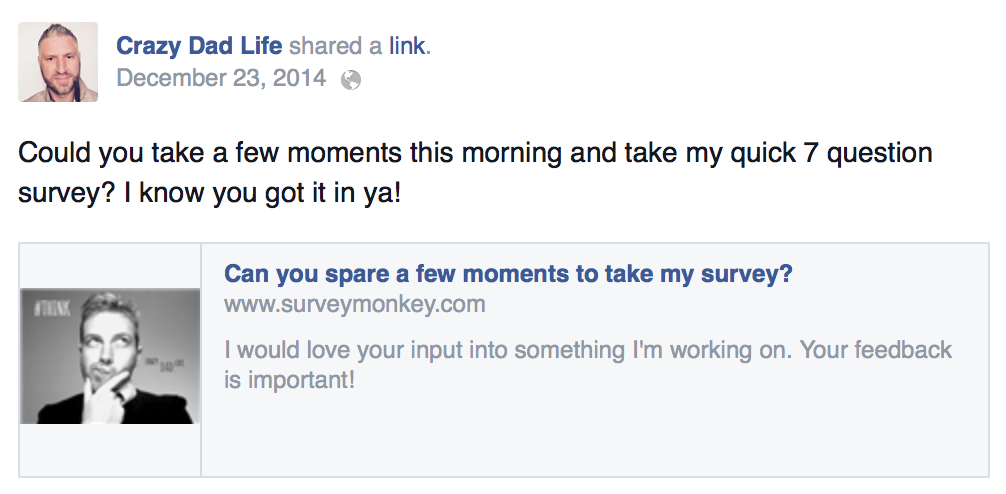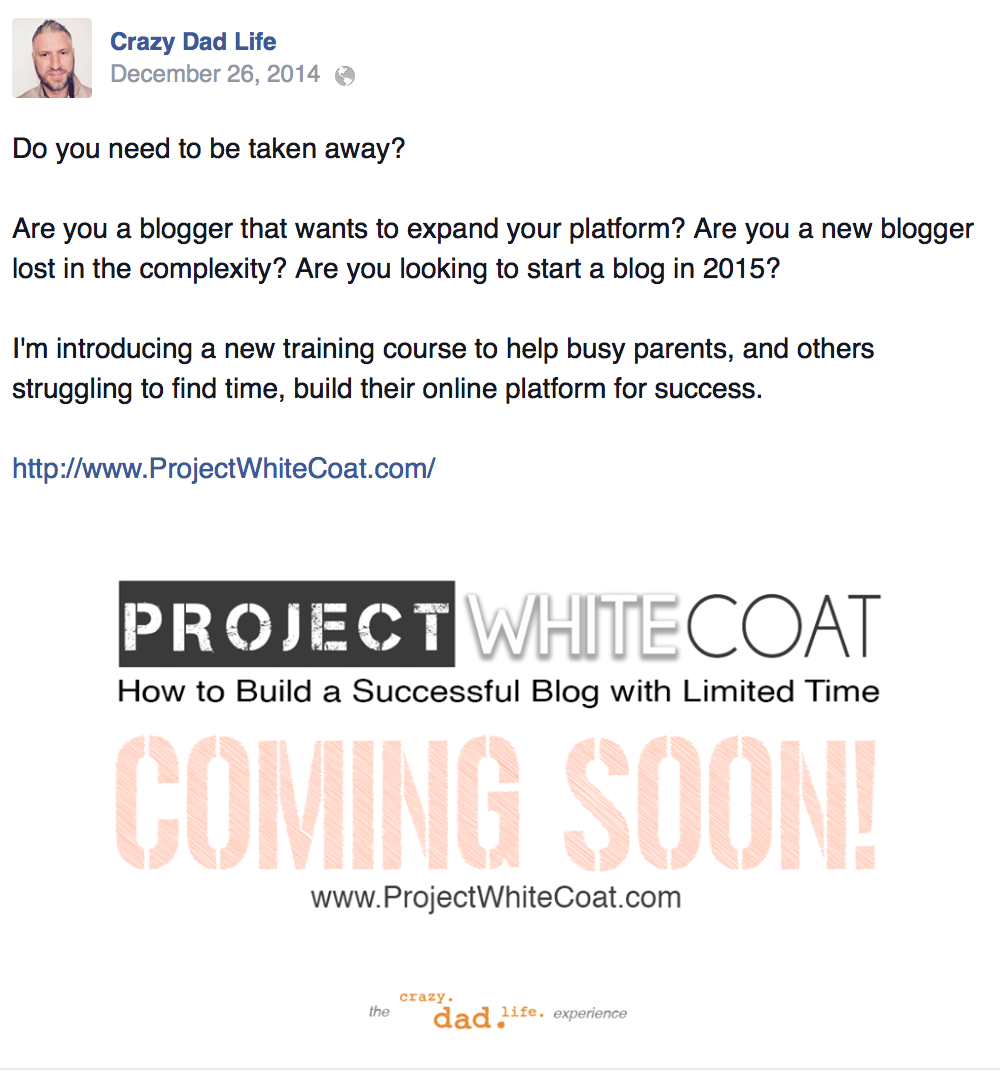Podcast: Play in new window | Download
Subscribe: iTunes | Android | RSS
 Give Your Product Ideas the Best Chance for Success
Give Your Product Ideas the Best Chance for Success
It is safe to assume you have had a number of product ideas over the course of your life. It could have been a massive product that would change the world or a simple enhancement to an existing product.
At some point all of us have thought about making a product or offering a service.
If you identify yourself as an entrepreneur, you probably have these thoughts multiple times in a single day, and have the domain names to prove it.
Product ideas bounce randomly through your head at all times of the day, regardless of where you are or what you are doing.
In this week’s podcast episode, and in the post below, I share my experience with testing product ideas in an effort to best position your product for success.
What Do You Do When Your Product Idea Can No Longer be Ignored?
Let’s say the product idea dancing in your head just won’t go away. Let’s say it doesn’t get filed away along with all the other ideas as a “some day” project. Let’s say you really think you have found the “right one”. Now what do you do?
There are many things you could do at this point but perhaps the biggest thing you should do is research and get feedback.
My Case Study
You may think your product idea is the next big thing, but your potential market may ultimately disregard it and set it on a path destined for failure. This recently happened to me with Project White Coat. If you are unfamiliar with Project White Coat, let me quickly explain.
I interact with a lot of people online and I am continuously coming across parents that either struggle with finding time to build their online platform or claim they don’t even have time to start. I felt if I could do a brain dump and create a product that would package valuable and consumable content for them to take action, it would ultimately save them time and lead them to something fulfilling.
Given parents live a crazy life, I figured we all needed the men in white coats to come take us away at some point. The idea for Project White Coat was born.
So, what did I do next? Was there a way I could validate my idea before I spent the next 6 months in the basement building it?
 How to Test Your Product Idea
How to Test Your Product Idea
The good news is it is not that hard to actually test your product idea. But, there needs to be a method to the madness. You must first enter the research phase if you want to have any chance of success.
Blindly putting a product into the market because you like it, and think everyone else will, is a recipe for disaster.
I had to do the same for Project White Coat.
Market Research
First you need to determine what the current market looks like. Do searches based on your product idea and determine how many competitors are out there offering the same, or similar, product. Seeing competition is a good thing. That means there is a market.
A mistake many people make is assuming an empty market is ripe for business just because there are currently no companies offering the product. While this may be the case, it is a rather unique situation where you discover something that has not already been tried.
If you find an empty market, there is probably a reason for it. The demand most likely isn’t there.
In my case, there are literally thousands of products out there teaching how to blog, how to “do” social media, and everything else online. Even with the crowded market, I felt my idea was still viable given the fact it would cover more than just a blog and would dive into the mindset, strategy, and general lifestyle to help bring some form of structure to your overall online journey.
At least that was my thinking. But, was it enough?
So, I have my product idea, I determined there was a market of some sort, and I’m ready to go to the next step. Testing.
 Determine Who to Test
Determine Who to Test
Now that you know there is a market for your product idea, you’ll need to really narrow down the “who”. In particular, the “who” that you will target as your potential customer.
Some people refer to this as your Avatar, that one person that represents the perfect consumer of your product. Get as specific as you can to identify this person.
This includes attributes such as age, gender, education level, income level, and family status to name a few.
This person will not only be used as the baseline for when you actually create your product, but will also be the key person you target during your research phase.
My Avatar looked like this:
- Male
- in his 40s
- 2-3 active kids (most likely tweens and teens)
- full time job
- wants to start a side business or at least a blog
Yes that Avatar is eerily similar to yours truly.
I had the “what” and the “who”, but now I needed the “how” and “where”. My “why” was what sparked the idea in the first place and was touched on above when discussing the beginnings of Project White Coat.
Let’s get into the “how”.
 Determine How to Test
Determine How to Test
You have the product idea and now you know who wants it. What’s next?
Now you have to find them and ask them about it. The path you choose for how you do this may vary based on the particular subcomponent of your market.
Before you reach out to particular segments, you have to identify ways to ask them. Some of the more popular tools available to you include:
- Email correspondence
- Online surveys and giveaways
- Casual questions via social media
- Pre-sales of the product
- Webinars introducing the concept
- Traditional methods (i.e. phone/skype, in person, print ads) – Who does this?
How you implement these tools will be driven by the particular medium you are using, your expertise, your budget, your time, and the population you’ve identified for the test.
To touch on the strategies associated with each of these would result in a book not a blog post, so I’ll hit on the high level items here. In particular, I’ll talk about what I did for Project White Coat.
Set up an Online Survey
The main tool I wanted to implement was an online survey. So I turned to Survey Monkey. I didn’t want an intrusive survey with 100 questions, so I created a short 7 question survey that would allow people an easy way to provide insight into my project.
Rather than repeating the survey here, it would be easier for you to just see the actual survey. (Yes, that is a shameless plug to get you to go add your input to the project).
If you pay attention to the link, another strategy I used was to leverage the Pretty Link plugin so the survey link would be easy to remember. People I reached out to could simply visit crazydadlife.com/survey to participate. It made it easy for me to post on social media, mention in conversations, and talk about on the podcast.
Leverage Social Media
Perhaps one of the best environments to query potential customers is via your existing social media channels. Reach out to your followers and friends and ask them for their input.
Let them know you have a product idea and you would love their feedback. Most people will be more than happy to help someone out that is simply asking for input.
In my particular case, I had a couple of ideas that I was floating out there for review. I truly wanted help in determining what product would provide the best value. You may be surprised by the difference between what you think would be an awesome product and what people really NEED.
Your outreach can be in the form of a status update or a simple tweet. If the question is phrased in a way that piques their interest, addresses a pain point, or appeals to their emotion there is a good chance they’ll jump into the conversation or go to your survey.
Here is what I sent to my Facebook Community.
It was simple, non-disruptive, and easy to consume. I reinforced the fact it was quick and only 7 questions to hopefully quell any fears they had.
Another way to grow a groundswell of participation for your survey is to utilize giveaways or contests. There are a number of plugins out there that can assist with this process. If people have an opportunity to win something by taking a few moments to answer your question, it becomes a win for both of you.
Just make sure you offer a prize that resonates and means something to your particular audience. Offering something like an iPad may get a lot of responses, but perhaps those people simply want an iPad.
I didn’t want to implement a giveaway as I was really looking to garner input organically. That and I was too lazy.
Ask Your List
You’ve worked hard to build your email list, use it! The people that have signed up to your newsletter have given you direct access into their lives. Regardless of how much they get on social media or visit your website, they always check their email. That is the beauty of email lists and why we all build them in the first place. They provide direct access to those most interested in your message.
Reach out to them as they are your tightest community.
Just make sure you make it easy to consume, fast, and to the point. People typically don’t have the time to consume a long email just to answer a few questions.
I not only solicited feedback from my list but I also followed up with those that signed up for more information with follow up questions.
Why did I do this? Wouldn’t the test be considered done once they took the actual survey?
No. The survey is just one part. I wanted to have a conversation with the people that took that first step so I could truly understand their pain points so I could make sure it was addressed in the course.
Ask Your Friends and Family
Of course you can not forget about your friends and family. They are often the ones that will give you the cold hard truth and set you straight before you get too far down the wrong way. With that said, take their advice with a grain of salt. Sometimes they don’t understand, or don’t have the same entrepreneurial mindset that you have.
At the end of the day, thank them for their support and add it to your overall analysis.
I chose not to do ask my personal friends and family. Why? I don’t know. Maybe I still have some level of fear in me that wants to keep this whole thing truly separate from that part of my life.
I think many entrepreneurs struggle with how much they let those closest to them into their personal business pursuits. That subject is for a whole other conversation though so I’ll continue.
 The True Barometer of Interest
The True Barometer of Interest
You have come up with a product idea, done some research, and even solicited direct market feedback about your product idea. Now what?
Now you need to really let the rubber hit the road. This means you have to see if people will truly be interested in the product, maybe even those outside of your direct online community.
To do this, I set up a landing page for the product. The best tool to accomplish a beautiful landing page is LeadPages. You can literally stand up a landing page in minutes and have it ready for the world. They integrate with major platform components such as Mailchimp and WordPress so it makes it super easy to stand up.
You can check out my landing page here (again, shameless plug if you are interested in being on the list to stay aware of updates on Project White Coat).
If you don’t know what a landing page is, it is basically a one page website where people visit to typically receive something or sign up for something. It is not a full blown website per se, but really just a splash of information for the visitor.
In my case, I wanted to create a mailing list of those folks that were serious about building their online platform and were willing to sign up. It’s a very simple method to gauge interest. There is limited risk and if the product idea doesn’t hit with your audience, you simply take the page down and try again.
Once the landing page was up I was able to tell people to visit the website to learn more. Again, I did this via social media channels. Here is what it looked like on Facebook.
The intent of this post was to let people know something was coming. This is a tried and true method of building anticipation in your audience.
Think of the movie industry. What do major studios do for their summer blockbusters? They provide substantial previews and marketing, sometimes well in advance of the release date and sometimes before the movie is actually finished.
Sound familiar?
Take a cue from the entertainment industry and get the word out about your product, even if you are still working on it.
 Analyze the Results – Go Time?
Analyze the Results – Go Time?
Only you will be able to determine if you’ve reached critical mass to move your product forward. Did you need 5 people to sign up or did you need 1000 people to sign up?
At some point you need to take all of the information gathered across your platform, and dig into what it all means. Once you have done this, you should have a much better idea of whether your product will sink or swim.
It is at this point where you’ll be able to make a go/no-go decision for your product.
Before I close this post (which turned out much longer than intended) I want you to remember this. The process of researching and analyzing the feedback of your market should never stop. Even if you do the first phase of research and analysis, periodically follow up with your market to make sure you are still on point.
Ongoing analysis and adjustment to fit the need of your market will better position your brand for long term success.
What Tip Can You Share?
If you have a tactic or technique that you use when researching or testing your product, please share with the community in the comments below.


After doing all the things above, what conclusion did you come to for your project?
Gold star for your James! Glad you asked. As of this moment it’s moving forward. I had enough response that there seems to be a genuine need for the structure and strategy (as well as the how-tos) that I’ve mentioned.
I’m planning on further research to really hone in on the best approach before bringing it to market though. Oh, and finding some time to make it happen.
What research did you do for WeMontage.com?
I bugged the crap out of anyone who would listen. I had a bunch of early signups too via a landing page i made using launchrock.
What’s your revenue model going to be?